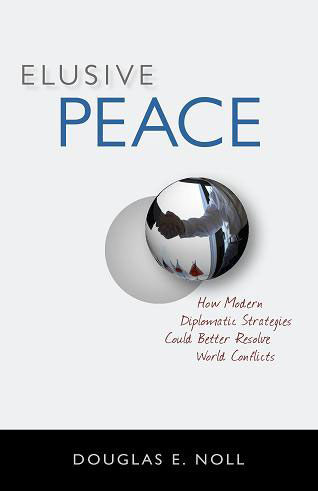Excerpt from Chapter 2 - Mediators and Hurricane Chasers
International mediation as practiced today, like international relations theory in general, is based on the assumption that because people are rational, they will respond to threats and promises. This view of mediation is summed up by a famous quote from Henry Kissinger, “When you have them by the balls, their hearts and minds will follow. ” International scholars and diplomats believe that through the use of coercive threats and promises, people in a conflict can be led to a negotiated settlement. It is hard ball diplomacy, and the mediator should use every tool in his box to drill, cut, rip, gouge, glue, and clamp parties to peace.
This philosophy treats the causes of conflict as objective issues that can yield to negotiation. Peace is only possible when the conflict is “ripe” for resolution. If the parties aren’t there yet, a judicious use of force might push them to be more amenable to peacemaking. Even then, these power mediators believe that parties have to be coaxed to the bargaining table through a combination of carrots and sticks. Tactics might include coaching, discrediting, manipulating, legitimizing, making the mediator indispensable, exploring changes in military balance, exploring changes in leadership, and promises of resources or threats of withdrawal.
The problem is that the big stick and bushel of carrots become substitutes for motivation. If parties are induced to come to the peace table because of the promise of an international airport or billions of dollars in foreign aid, their underlying needs and desires are not being addressed. People who come to peace negotiations out of fear of threat are not motivated to negotiate because of their own desire for peace, but instead because of their fear of the consequences if they do not come to the table. As we will see when the negotiations get tough and emotions began to run high, parties have a much easier time leaving the table, being intransigent, or only agreeing superficially to peace if their motivation is based on some threat or promise.
For real peace to take hold, the parties must have hope that peace is achievable. They must be motivated to find a peaceful solution and must believe that it is possible. They must believe that the other side will be accountable and responsible for keeping promises made in peace agreements. The mediator is responsible for creating, nourishing, and bringing these beliefs to blossom.
Sometimes the big stick and bushel of carrots approach to mediation is useful because it provides political cover for leaders. Leaders can approach their constituencies and say “What else are we to do? If we do not appear at the table, we will be pounded into rubble.” In fact, the leadership may be looking for a face-saving way to negotiate a peace agreement, and the big stick or big carrot may be just what is needed for that purpose.
Carrots may also provide evidence of tangible benefits to constituencies. Peace by itself may not have enough immediate economic or political effects to motivate agreement. A peace agreement may mean giving up something of value, such as a military advantage. Carrots become replacements for concessions so there is less sense of loss.
In August 1975, Henry Kissinger mediated the Israeli-Egyptian interim peace agreement known as Sinai II. Kissinger induced Israel to make territorial concessions to Egypt in exchange for U.S. aid. Both the Israeli and Egyptian negotiators returned to their constituencies with tangible benefits of an otherwise odious peace agreement. As a result, in 1976, annual aid to Israel rose to $2.2 billion, and economic aid to Egypt grew to nearly $500 million .
Carrots have limits, however. Generally, you can’t buy peace with increased aid. Money does not defuse a crisis or substitute for basic political will. The lesson for mediators is that deep engagement with the parties resulting in a commitment to peace is essential. During the Oslo years, the Palestinians were not fully engaged with Washington. While much is made of President Clinton's visit to Gaza and Arafat's many White House visits, the relationship between them was so thin that Arafat was willing to walk away from it at Camp David, and Clinton was willing to cast it aside afterwards when he blamed Arafat and the Palestinian leadership for the summit's failure.
Sticks don't work so well either. Economic sanctions are often ineffective as instruments of peace. In his study of five major cases of U.S. sanctions, Ernest Preeg concluded that sanctions “have been almost entirely ineffective in achieving their intended foreign policy objectives while having a substantial adverse impact on other U.S. foreign policy and commercial interests.” Margaret Doxey has argued that sanctions can achieve modest gains of the “slap on the wrist” variety but that “a major change in policy is . . . harder to come by.” The definitive empirical work in the field, conducted by Gary Hufbauer and his colleagues at the Institute for International Economics in Washington, concluded, “Sanctions are seldom effective in impairing the military potential of an important power, or in bringing about major changes in the policy of the targeted country.”
In addition, using sticks avoids the important work of understanding the complexity of the conflict. People enmeshed in conflict make choices independent of the mediator and will hold intense feelings of hatred, frustration, fear, and mistrust. These feelings lead to decisions that do not resemble the prudent cost-benefit outcomes one might expect with the cold calculus of rational choice. Power mediators consistently underestimate the resolve of groups whose members are willing to kill and die for their cause. Their visceral hatred for negotiations cannot simply be dismissed as stubbornness or a ploy for a bargaining advantage.

